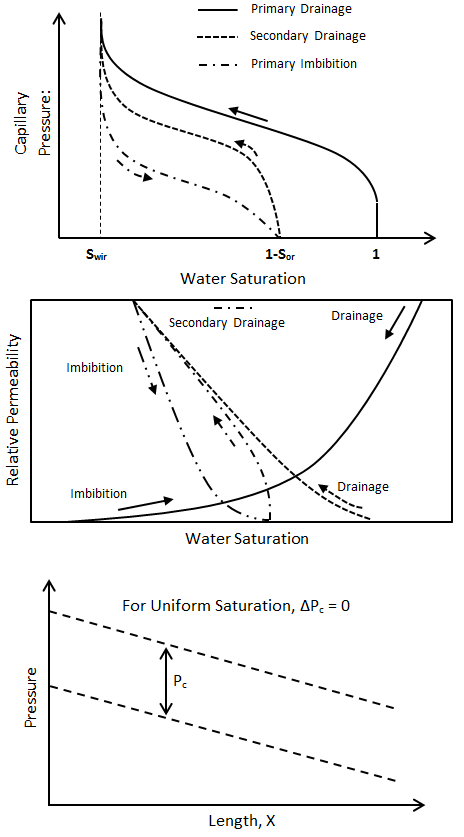Fundamentals of Fluid Flow in Porous Media
Chapter 2
Relative Permeability
Comparison Between Capillary Pressure and Wettability
Similarities and analogs between capillary pressure and relative permeability curves for a two phase system is shown in Figure 2‑83.

Figure 2-83: Comparison Between Capillary Pressure and Relative Permeability Curves
Fluid Distribution in Two Phase Flow
There are several important points regarding the distribution of fluids in porous media under two-phase flow condition. The wetting phase seeks to maintain its continuum in the network of pore space involving the relatively small pore throats connecting pore bodies. While the non-wetting phase seeks to maintain a continuum in a pore network involving the large pore throats. As the non-wetting phase saturation increases, the wetting phase is “trapped” in the pore spaces accessible through relatively small pore throats. However, as the non-wetting phase saturation decreases, krnw decreases (i.e. imbibition displacement) the wetting phase imbibes into relatively small pore throats and pore bodies in a hierarchical manner. This results in the non-wetting phase being trapped in the relatively large pore bodies and large pore throats connecting trapped oil in pore bodies. Also, in a water-wet formation at S*or conditions, only water is flowing and kro(S*or) is equal to zero. However, if the formation is oil-wet, at S*or conditions, kro(S*or) is very small (10-2) but never becomes zero because of wetting “film” flow. Additionally, if the IFT is very small, there is a significant change in the relative permeability characteristics.
Relative Permeability Plots and Characteristics
The following summarises some important points about relative permeability and relative permeability curves for water-wet and oil-wet systems:
Water-wet system:
- krw = kro at Sw > 0.5,
- krw at S*or is less than 0.3 (S*or is the waterflood residual oil saturation),
- The amount of connate water saturation, Swc, is usually greater than 20% (Swc ≅ 20 to 25% PV) and has an effect on relative permeability behaviour,
- ( kro )primary drainage > ( kro )imbibition for the same Sw,
- The krw curve exhibits no hysteresis ( e.g., ( krw )pd = ( krw )imb ),
- As permeability increases, ( krw / kro ) becomes higher for a given saturation.
Oil-wet system:
- krw = kro at Sw < 0.5,
- krw ( S*or ) > 0.5,
- Swc has no effect on relative permeability behaviour, if Swc < 20%,
- krw( Sw ) | primary drainage > krw( Sw ) | imbibition,
- kro curve exhibits no hysteresis,
- As permeability decreases, ( krw / kro ) becomes higher for a given water saturation.
For both oil and water-wet systems, the sum of ( krw + kro ) is always less than 1, when the same base permeability is used for normalization ( i.e., ( krw + kro ) < 1 ). The main reasons for this are: 1) dendritic to flow pore space; 2) the connectivity of the network of each of the phases in the occupied pores is much smaller than that of the porous medium under single phase flow; and 3) pressure of immobile (trapped) fluids.
Questions?
If you have any questions at all, please feel free to ask PERM! We are here to help the community.
